Wittenberge is located in the Prignitz region of Brandenburg, directly on the Elbe River. The town is located almost exactly in the middle on the railway line from Berlin to Hamburg. With a twinkle in their eye, the people of Wittenberge like to refer to these major cities as their suburbs.
In the course of the German settlement of the Mark Brandenburg, Wittenberge was founded by the Gans family. A document from 1300 confirms the town’s town charter.
The Thirty Years’ War, major fires in 1686 and 1757 and Elbe dyke breaches (1709 and 1761) destroyed large parts of the town and led to high losses among the population.
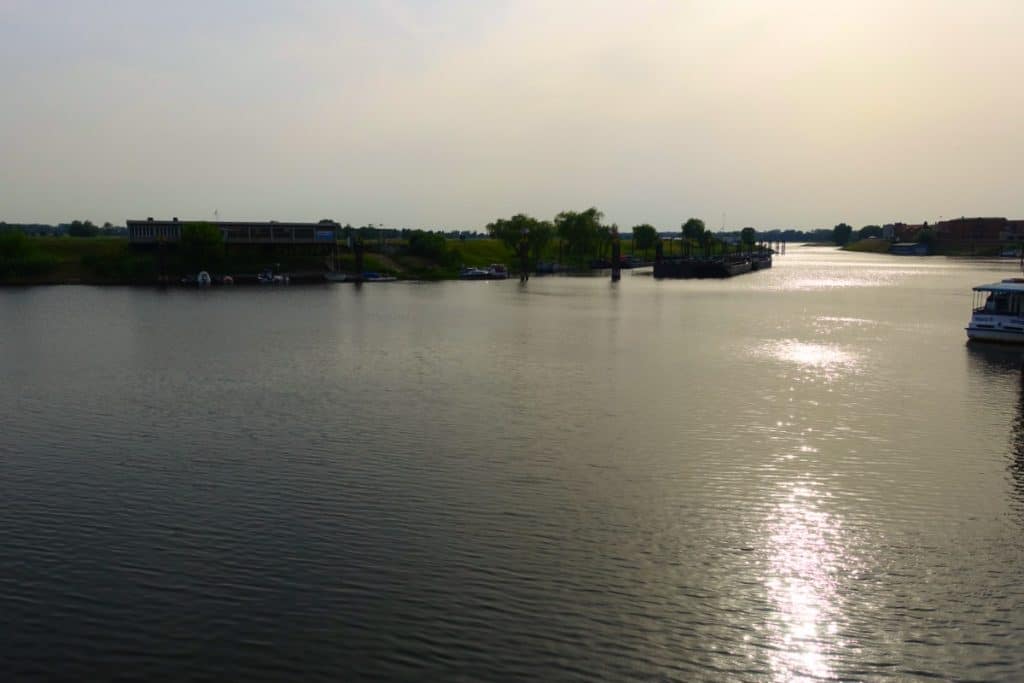
From 1820, with the arrival of the first steamship on the Berlin-Hamburg passenger line, the tide slowly began to turn. The industrial boom began with the construction of Simon Herz’s oil mill in 1823. After the Elbe harbour in 1835 and the connection to the railway line in 1846 (Berlin-Hamburg) were achieved as the first milestones, further important steps followed for the development of the city. Further railway connections were created in the direction of Magdeburg, Lüneburg and Salzwedel, and a soap factory (1846), a chemical factory (1849) and a railway repair works (1875) were built.
The town got its next big economic boost in 1903 when the US company Singer built a large sewing machine factory. The well-known Singer sewing machines were built there until 1945. In GDR times, VERITAS and Naumann continued to build sewing machines there, which were sold worldwide.
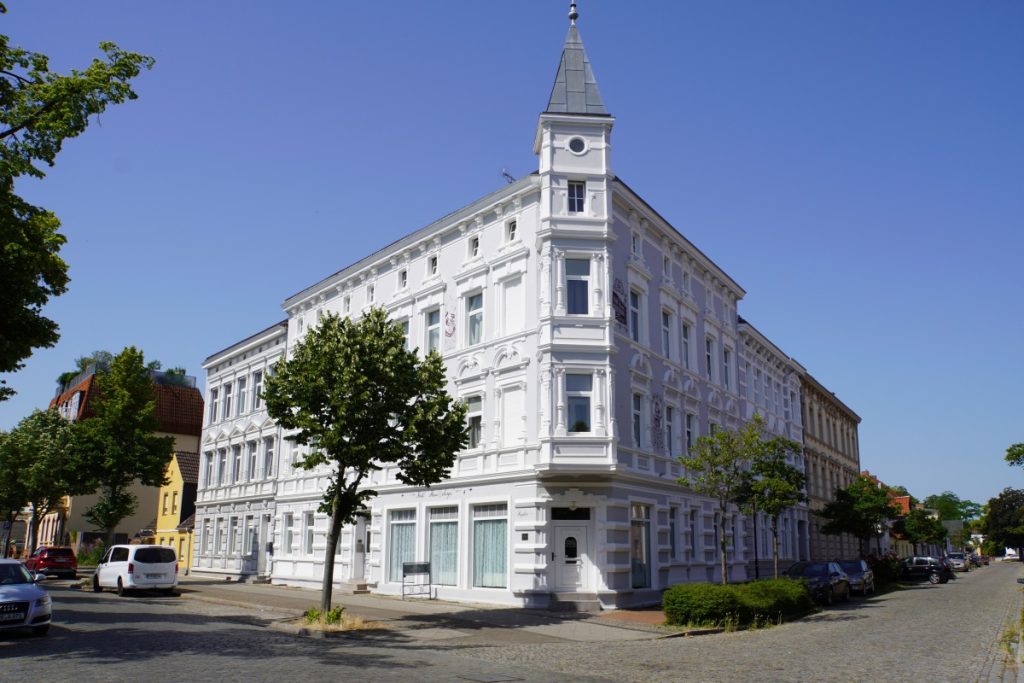
The oil mill, the Singerwerk and the good railway connection attracted other large companies to the town. The number of inhabitants increased rapidly and new living space was urgently needed. Numerous residential buildings were built, especially between the old town and the railway station, which is about 1 kilometre away. Today, particularly beautiful buildings with beautiful Art Nouveau facades stand here.
With the beginning of the First World War, the economic boom in the city was significantly dampened. In the Second World War, air raids destroyed industrial plants, transport facilities and residential areas.
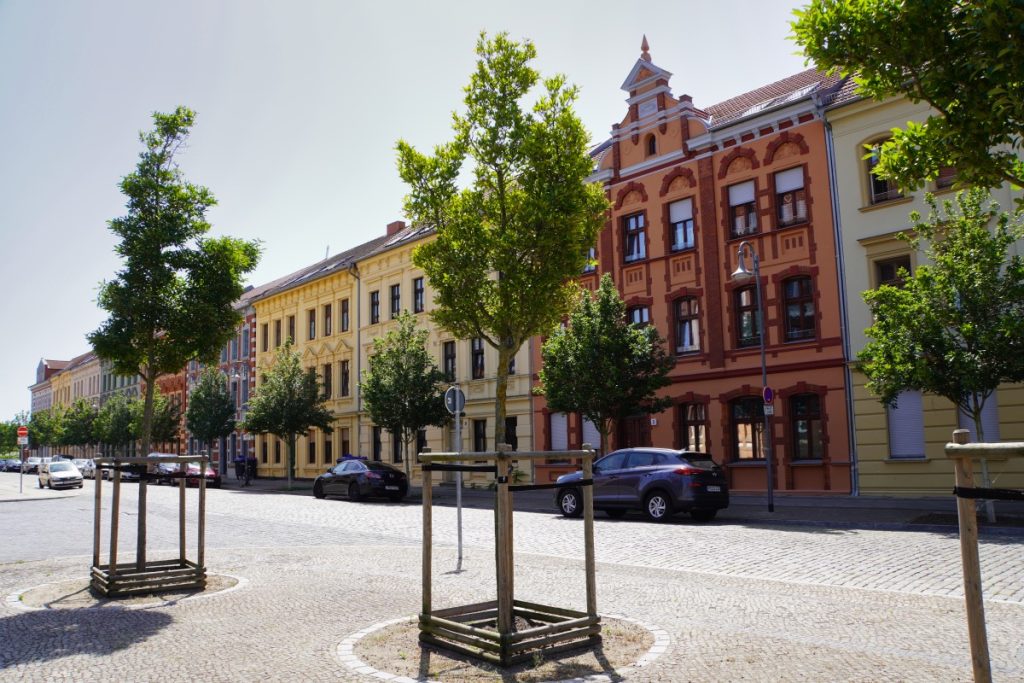
In the days of the GDR, the sewing machine factory, the pulp mill and the oil mill provided a relatively stable economic basis in the town. This changed with reunification. The factories were closed, jobs were lost and many residents moved from Wittenberge to other regions.
Places of interest in Wittenberge
A city walk is a great way to explore the most beautiful sights in Wittenberge. If you want, you can learn everything you need to know about the town on the Elbe on a guided tour of the town, which is offered on a variety of themes.
Wittenberge Town Hall
In August-Bebel-Straße in Wittenberge stands one of the town’s most impressive sights, the beautiful town hall. Right next to the town hall is the town’s Soviet cemetery of honour. The Soviet representative at the time had this cemetery placed as close as possible to the “city’s centre of power” so that the victims could always be remembered.
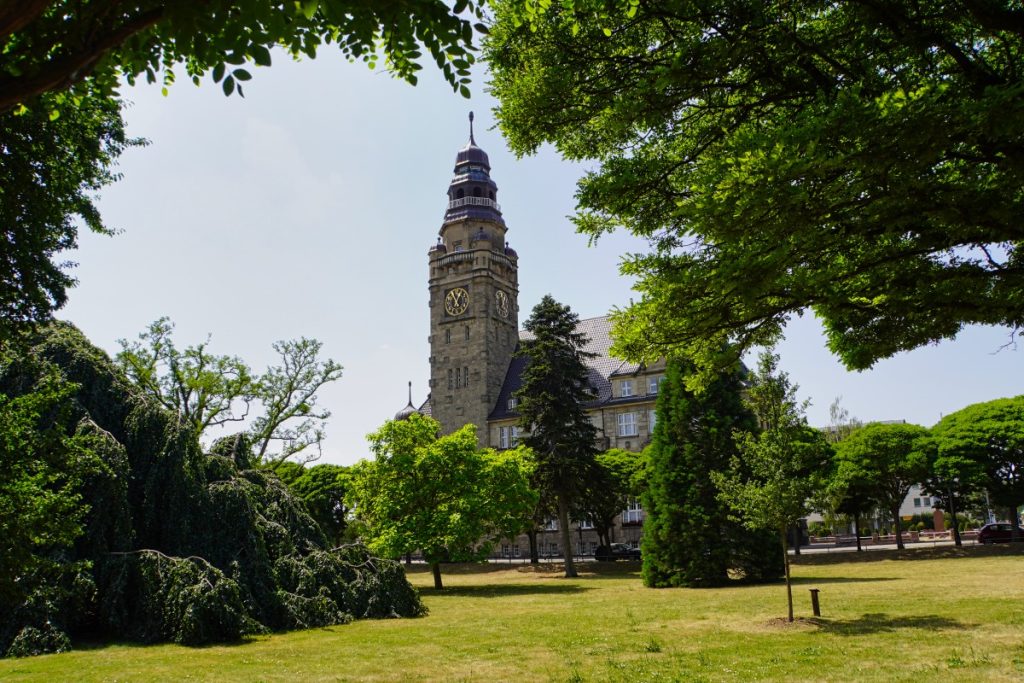
In 1914, the building, which was designed by Bruns, was inaugurated. The building, which cost a good 600,000 marks, enabled the growing city to adapt its administration accordingly.
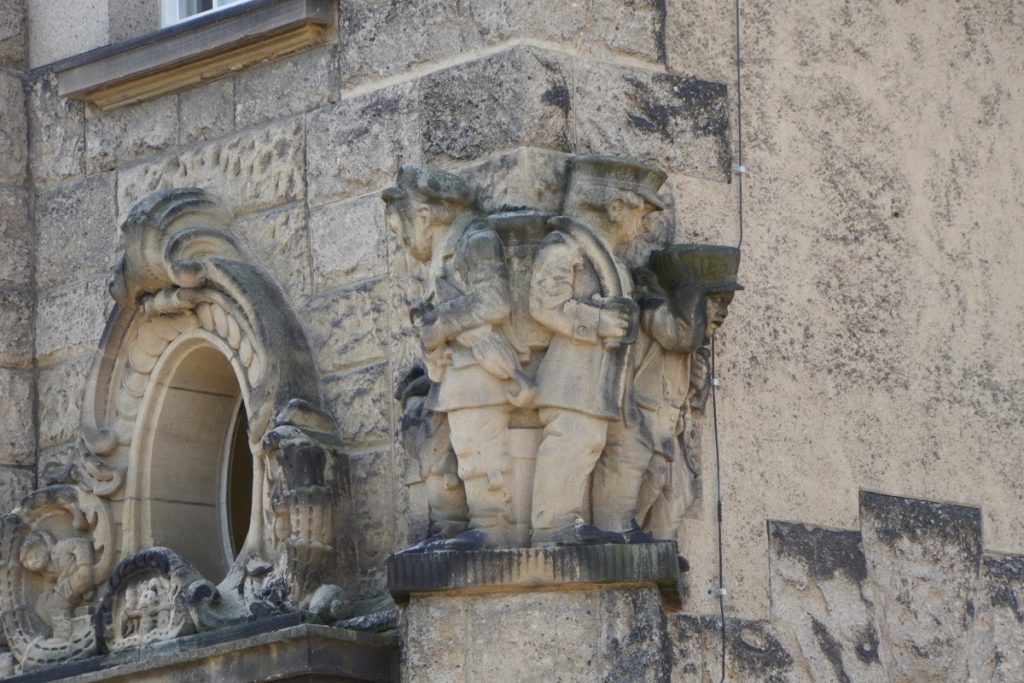
The building has an almost square ground plan of 44 m x 43 m and a town hall tower with a height of 51 metres. The exterior façade is decorated with a wide variety of sandstone decorations. For example, at one point you can see a night watchman leading away two good-for-nothings. Due to the rustic façade, the town hall could certainly be classified as Neo-Renaissance. However, there are also decorative forms that suggest neo-baroque and neo-classicism. More precisely, however, the building is classified as Historicism.
In the town hall
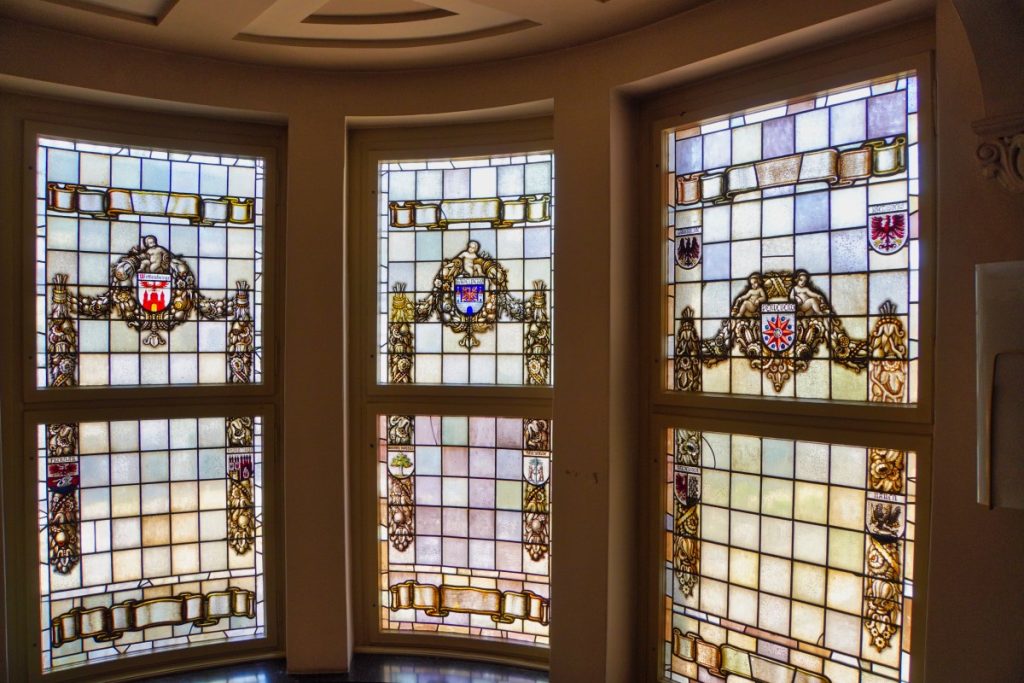
Hard to see from the outside are the beautiful leaded windows and the painted windows. We were able to look at them closely from the inside and I was very impressed by the attention to detail and colourful design of the panes.
When you enter the staircase of the town hall, you are confronted with windows with 46 different city coats of arms. Why these cities are depicted is not entirely known.
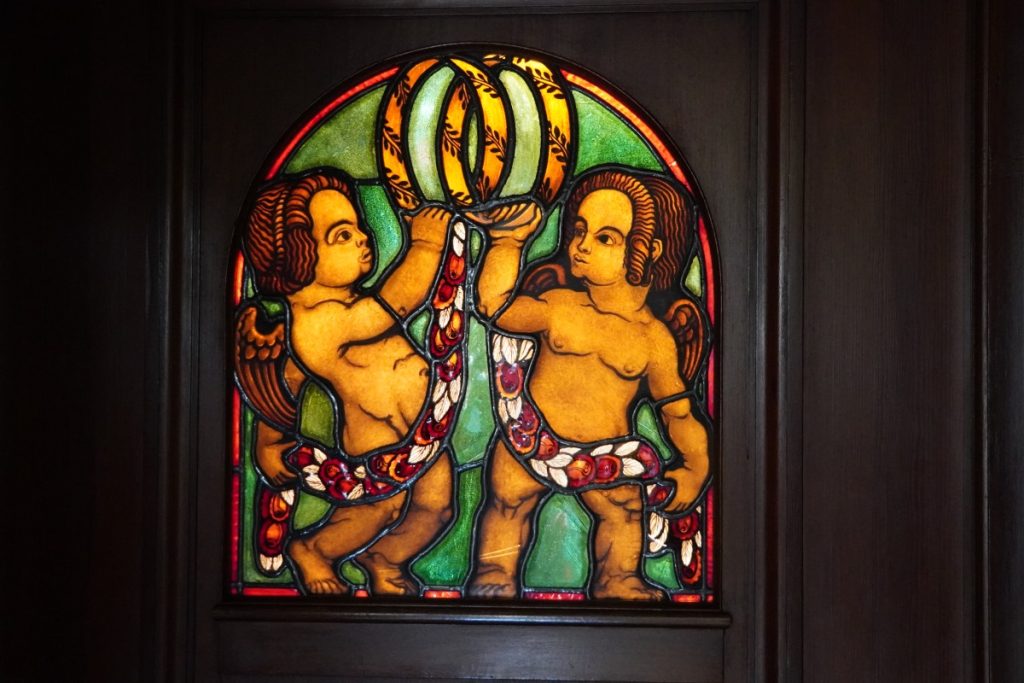
A look into the small wedding room almost left me speechless. Not only the beautiful and also symbolic window in the door, but also the impressive window in the wedding room surprised me very much. We first entered the small room without artificial light and thus only experienced the effect of daylight. The windows were reflected in the smoothly polished table of the registrar and the room was pleasantly dim. I believe that looking at the window is the ideal distraction for brides who are quick to cry. Anyone looking at the detailed depictions here will certainly quickly forget the world around them – and as long as they don’t forget to say “yes”…
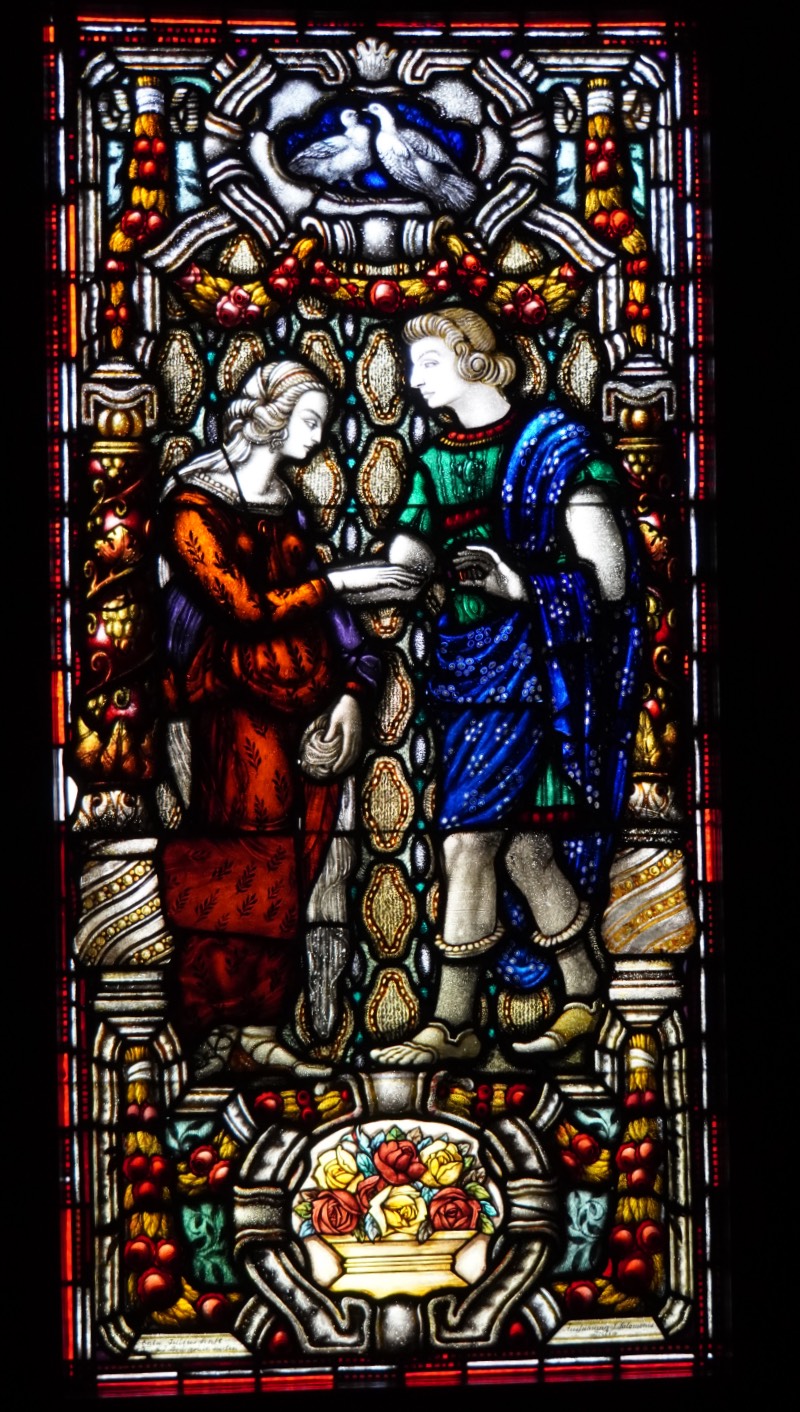
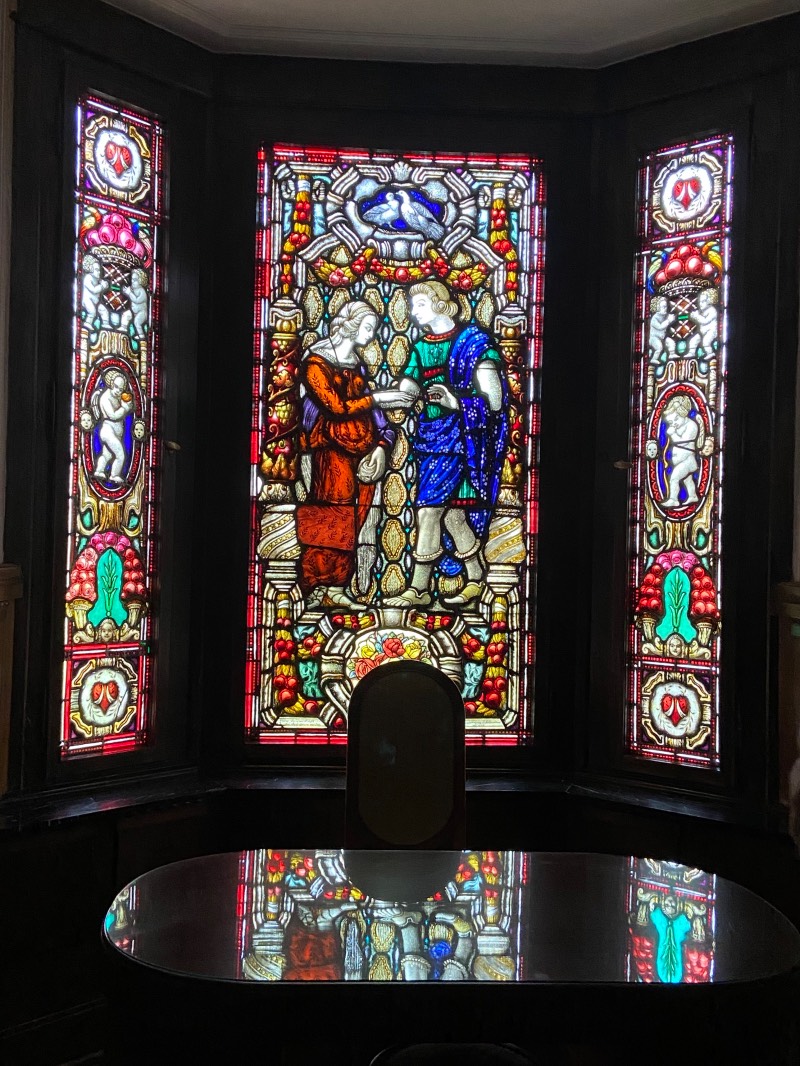
In the Great Marriage Hall, the original meeting room, the first thing I noticed were the massive chairs. Even though they don’t seem particularly comfortable, they fit perfectly into the dark-panelled hall. The real highlight here, however, are the large colourfully painted windows. All five windows together form a picture. A long boat is sailing in a large river. Each section addresses a particular area of life in Wittenberge.
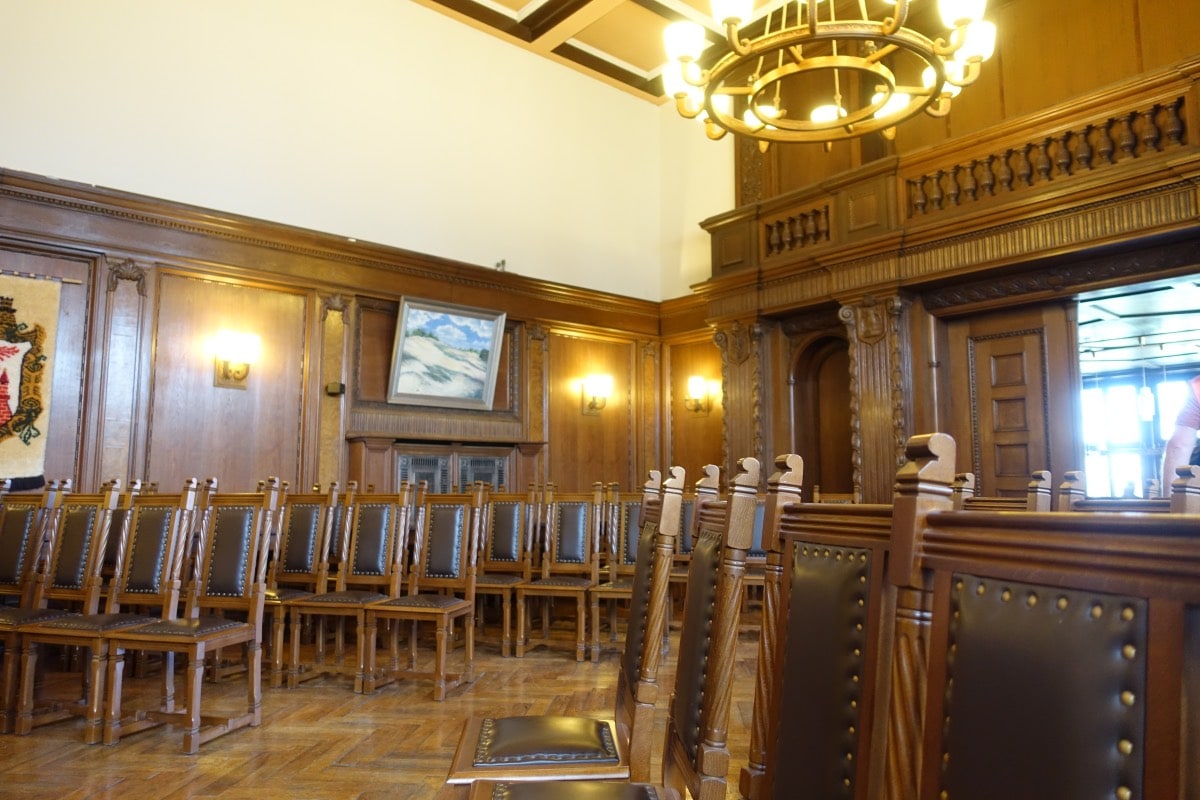
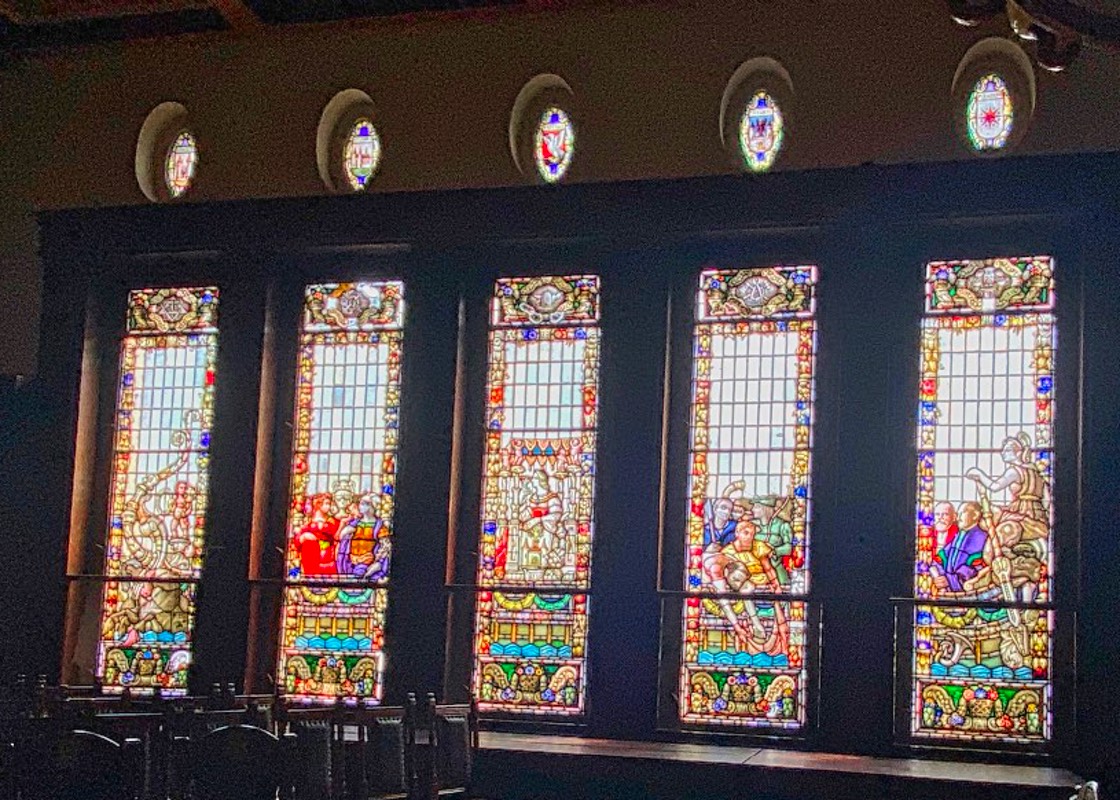
View from the town hall tower
Finally, we climbed 115 steps up the town hall tower. While climbing the tower, you can read information boards on the retracted mezzanine and see the large old town hall clock. 37.5 metres up, there are small balconies, each with a view in one direction, from which you can discover the sights in Wittenberge. You can see the most important places in the town very well from up there. And with a bit of luck, the kestrels fly around the town hall and take a little break on the roof.
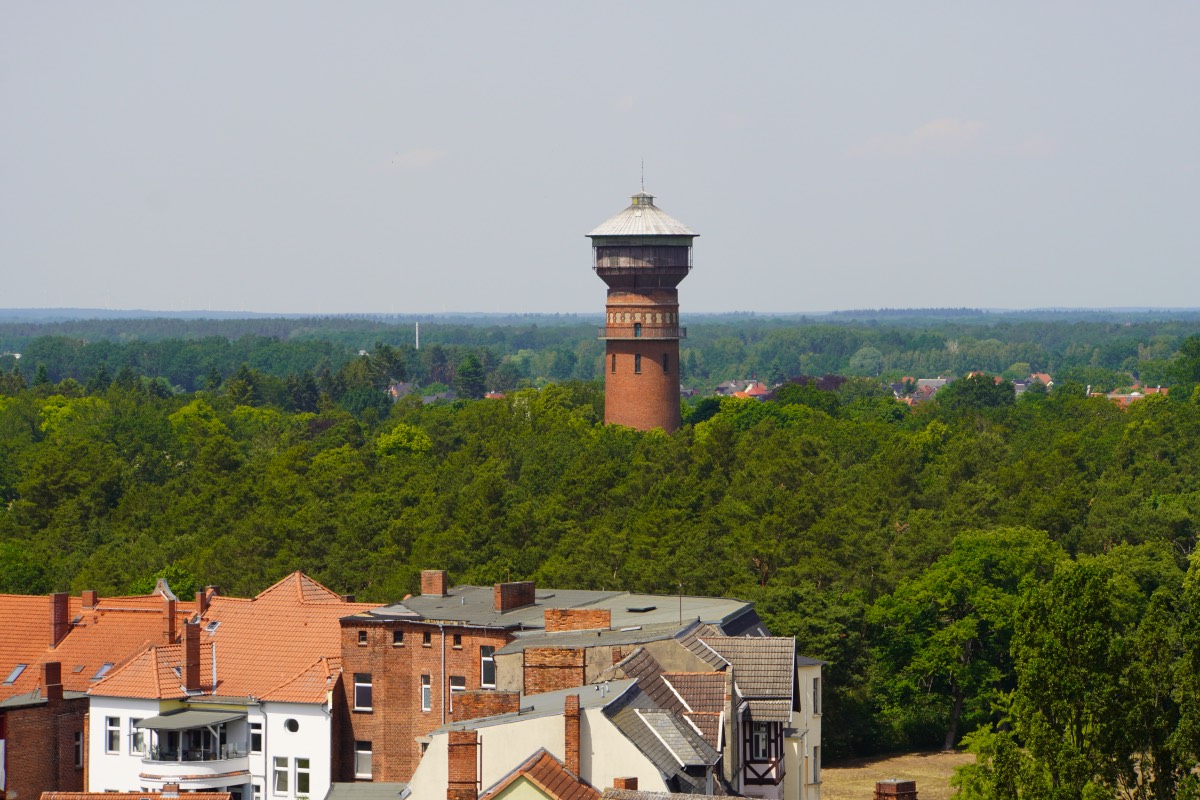
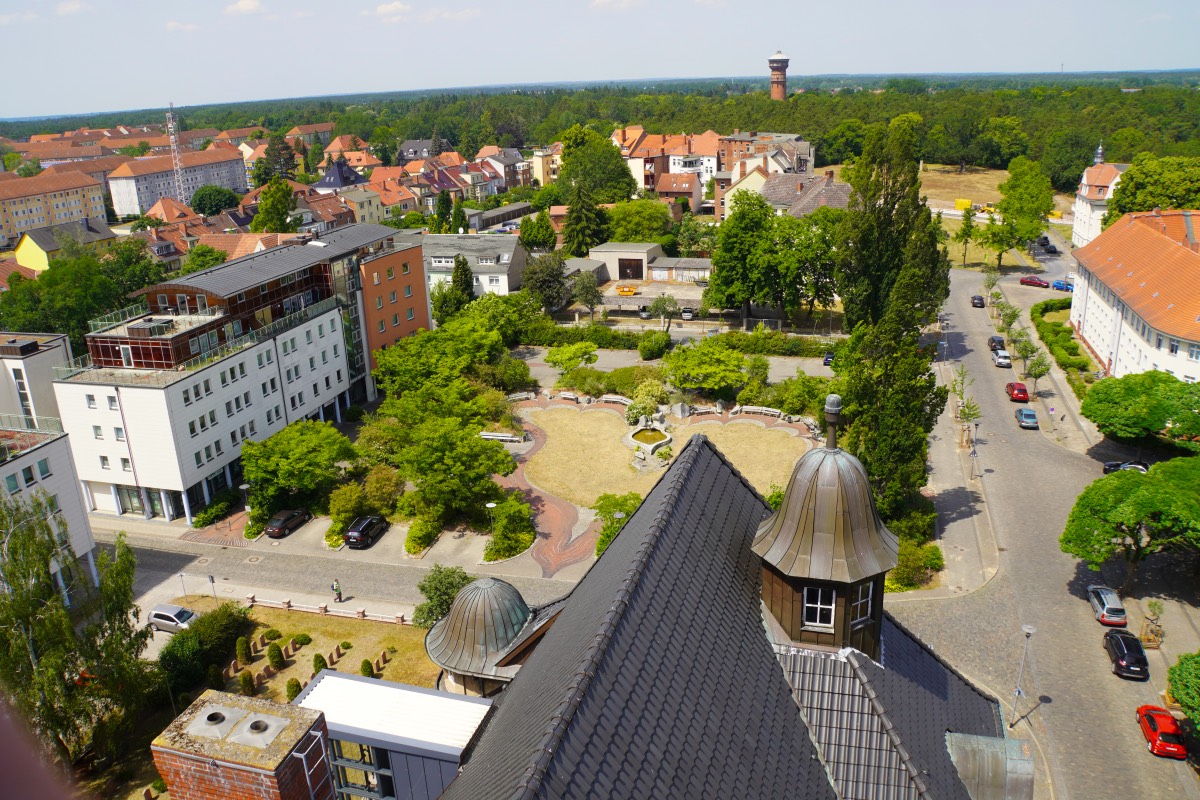
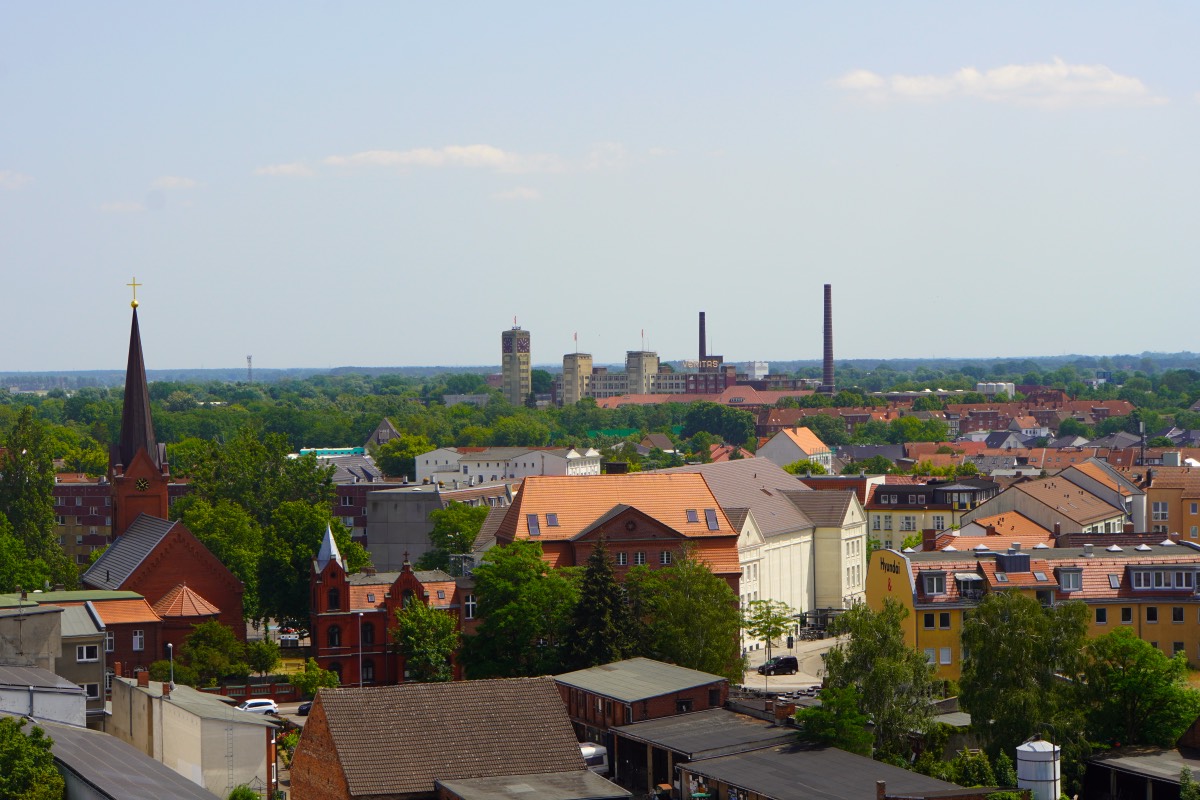
Guided tour of the town hall with tour of the tower open to the public without advance booking
April – October
as part of the city tours
Price: 5,- €
Individual tower tours possible:
April – October
Monday – Thursday: 8:30-16 h,
Friday: 8 -12 h.
(except public holidays)
Evidence of Art Nouveau in Wittenberge
Art Nouveau is an art historical epoch at the turn of the 19th and 20th centuries. It has, like actually every style, different characteristics depending on the region. Decorative curved lines as well as large-scale floral ornaments and the common endeavour to turn away from historicism can be found in all forms. The façades of houses built in Art Nouveau style no longer had to be symmetrical and determined by axial divisions, but were allowed to follow a spatial idea developed from the ground plan.
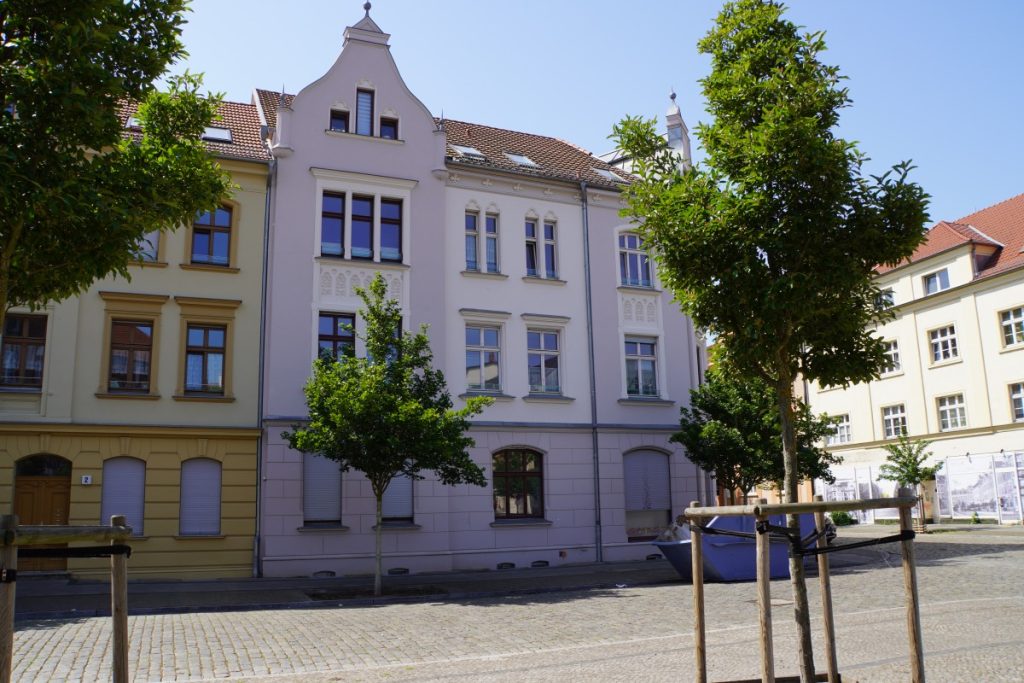
The phase in which Art Nouveau was “modern” lasted about 20 years. The exact end date cannot be given, of course, but around the First World War the era of Art Nouveau ended.
The economic boom began in Wittenberge at the end of the 19th century. New living space was urgently needed and so tenement houses were built in rows in newly developed residential areas, which today are among the sights in Wittenberge. Until around 1909, the builders designed the façades in the Art Nouveau style.
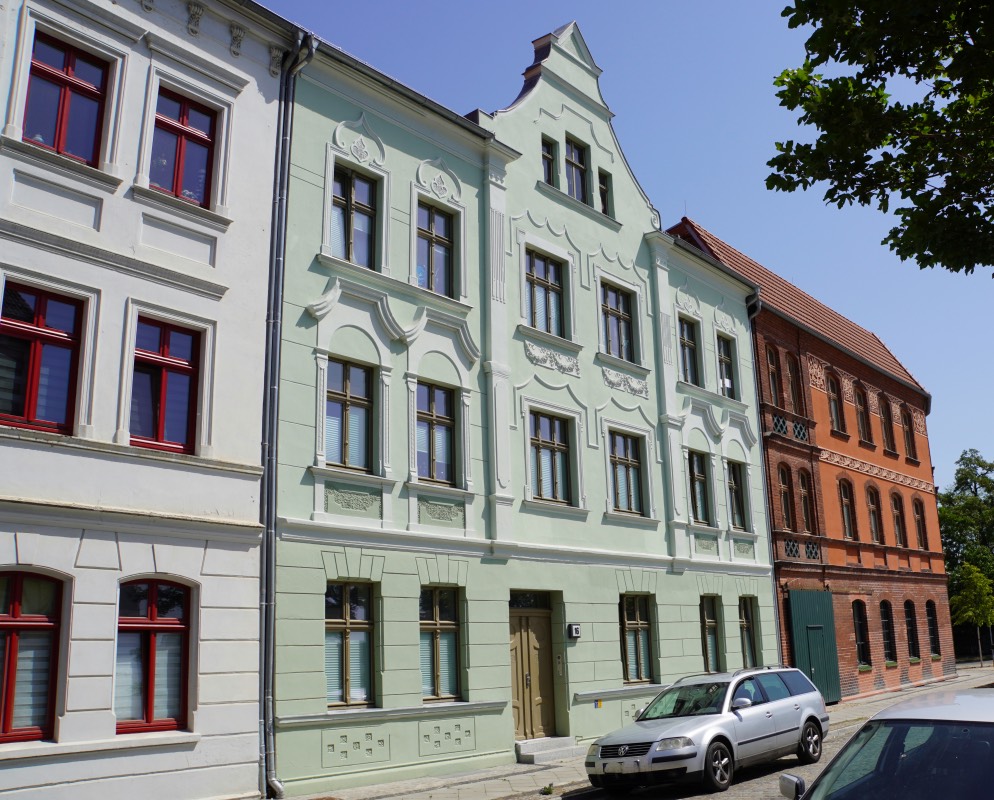
If you walk along Johannes-Runge-Straße, for example, you will discover stylistic elements such as shamrocks, little clouds or other floral patterns on the façades. In some streets, the houses have been beautifully renovated and their colourful facades look inviting and cheerful. Every now and then, there are houses in the street rows that have not yet been renovated and are waiting to be revitalised. Unfortunately, other houses could not be completely preserved due to war damage and today only a piece of the façade reminds us of the house there.
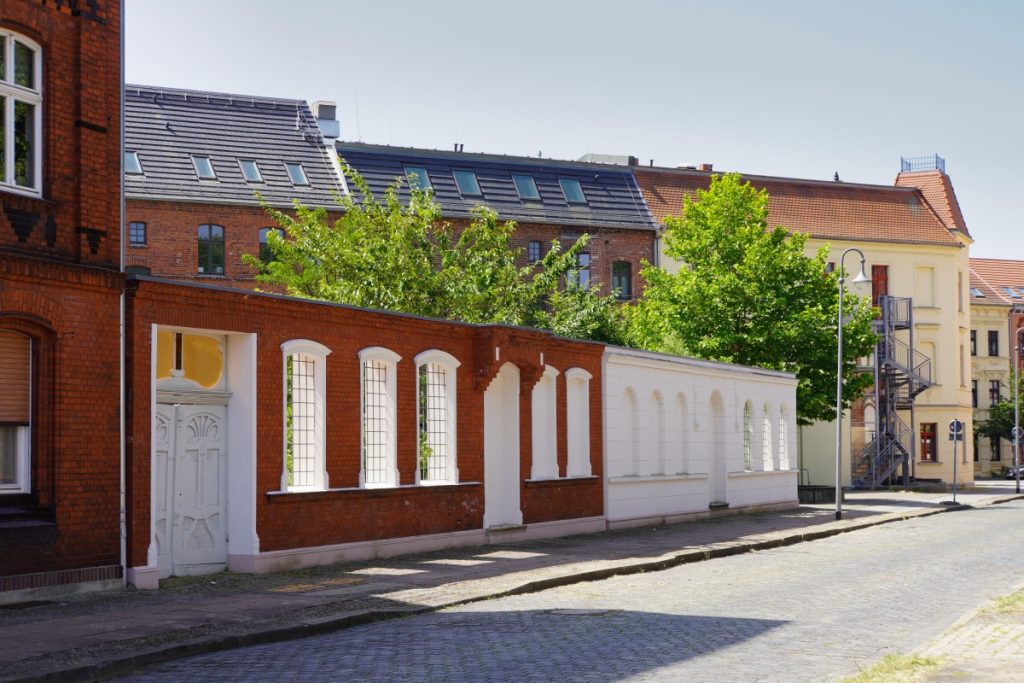
I was particularly struck by the entrance doors, some of which are original and individually decorated. In some houses you can also find the colourful skylight windows that were common in the Art Nouveau style, which give the rooms behind them a very special light.
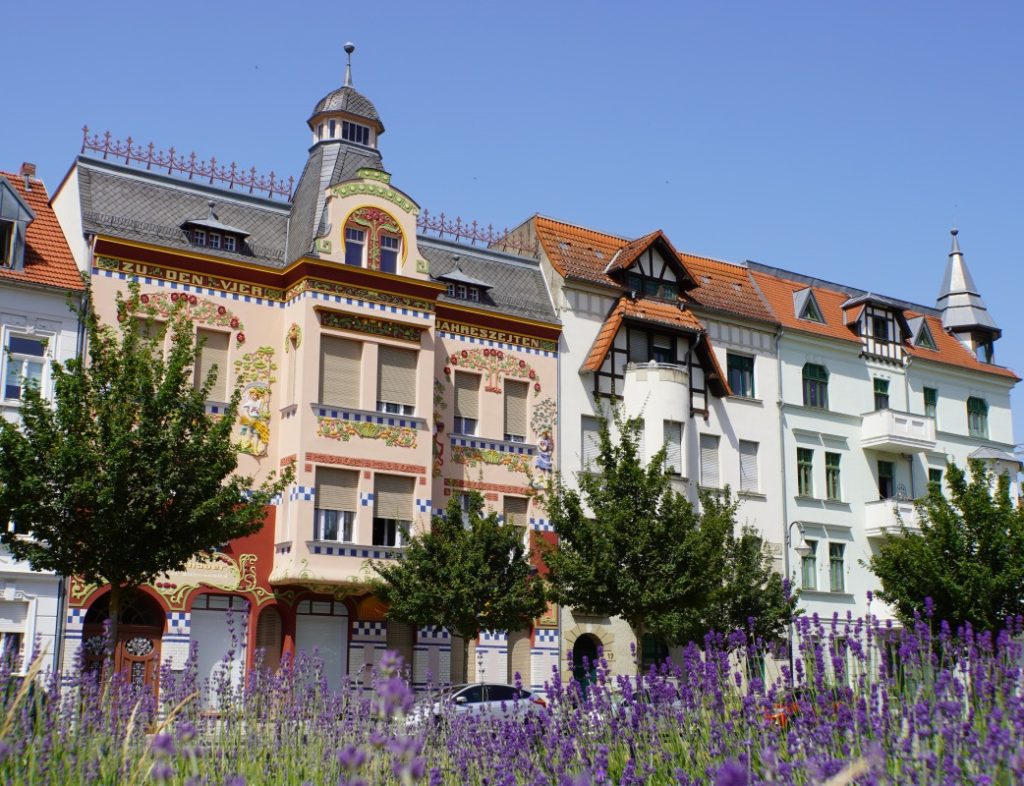
Probably the most striking house designed in Art Nouveau style belonged to a stage designer. The “House of the Four Seasons” is designed in bright, strong colours. In my eyes, it is almost too colourful and playful; floral and geometric shapes have been applied to the façade. Four large figures, symbolising the seasons, stand in front of a tree and hold something appropriate to the season in their hands. Below this representation is a large sun with a face.
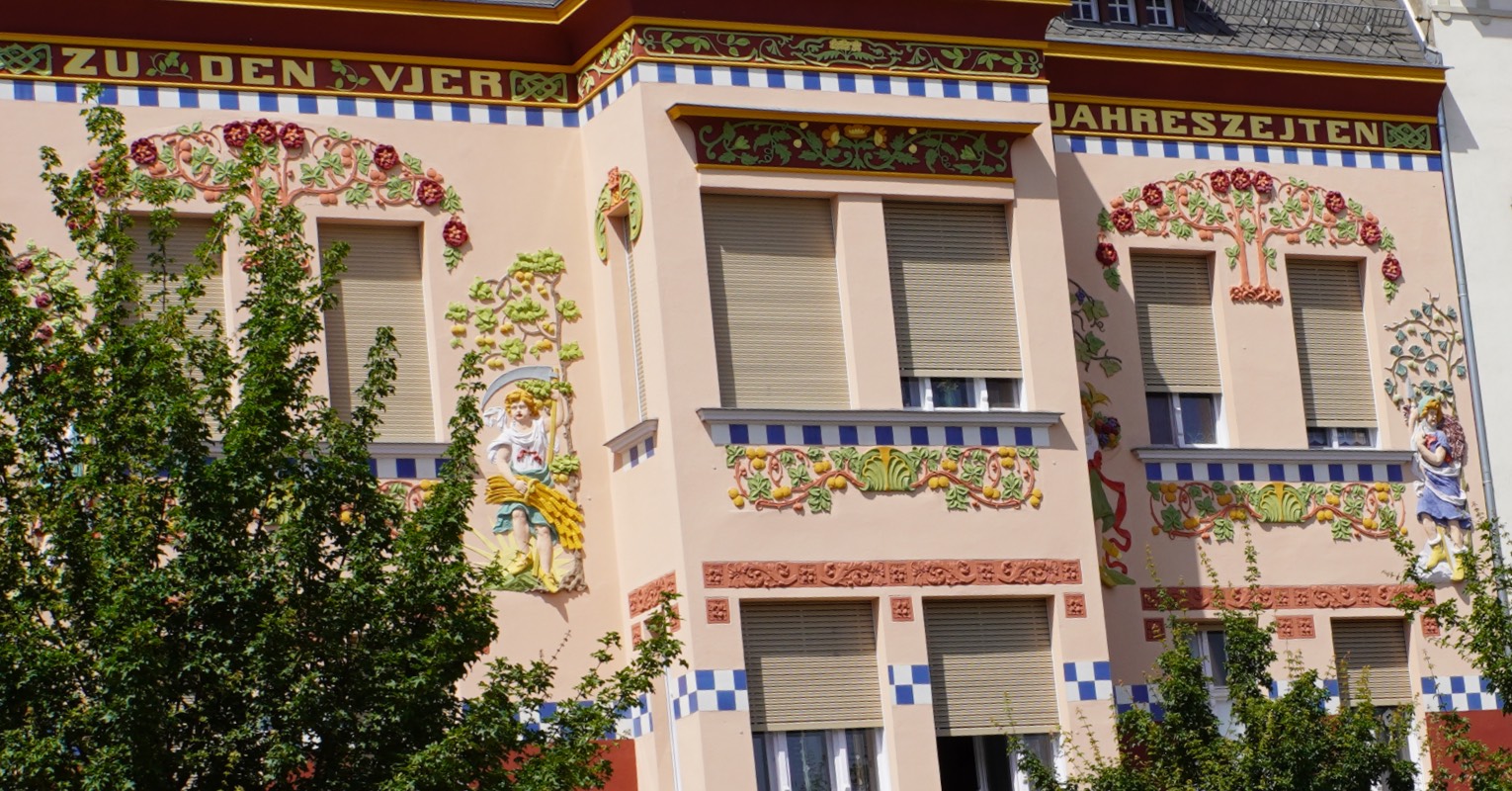
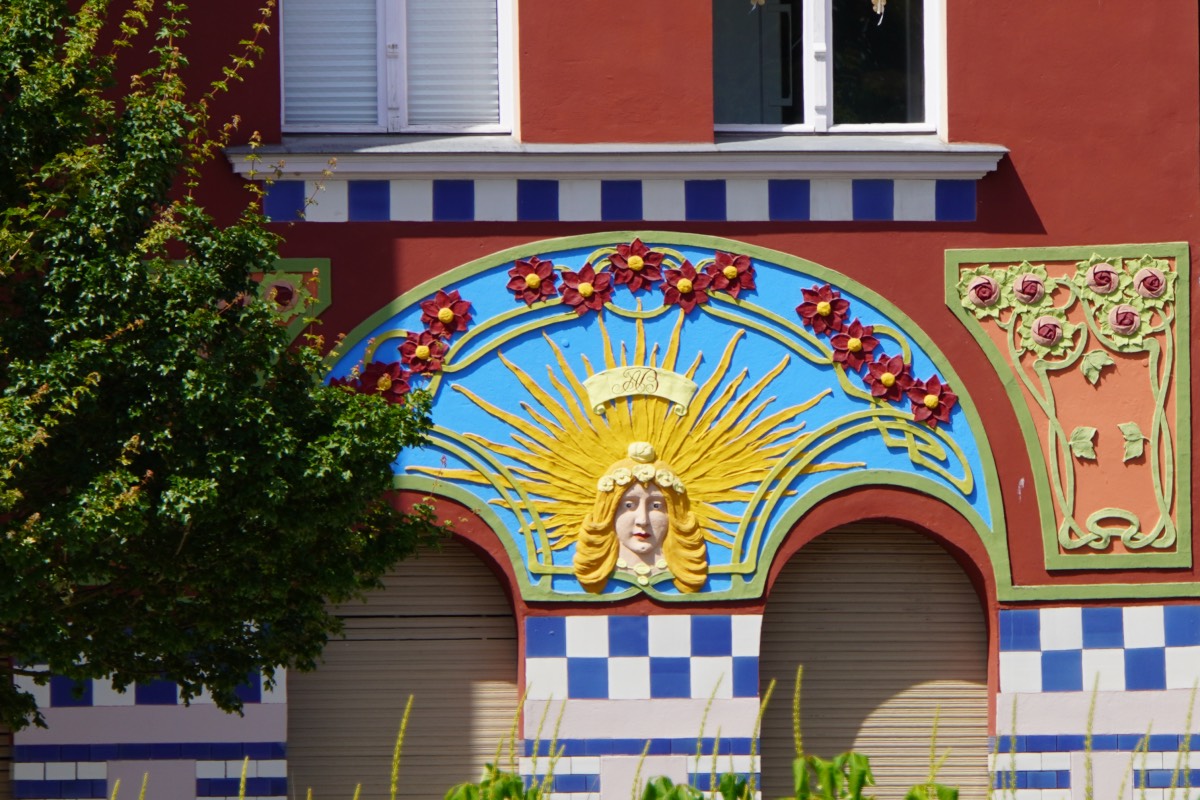
Art Nouveau tour open to the public without advance booking
April – October
as part of the city tours
Price: 5,00 €
St.Heinrich Catholic Church
In 1539, Joachim II, Elector of Brandenburg, broke with the Catholic Church and thus laid the foundation stone of the Reformation in the Mark Brandenburg. For almost 300 years, the Catholic Church had almost disappeared in Prignitz as well.
When the oil mill was built in Wittenberge in 1823, the first immigrants moved into the town. Craftsmen from the Eichsfeld, workers from Silesia and merchants from Westphalia came. Among them were also some Catholics. People had to travel to Ludwigslust (44 kilometres away), Stendal or Schwerin to attend a church service.
Salomo Beck, a Catholic from Eichsfelde, moved with his family to Wittenberge. It is said that his wife was very unhappy in the town because there was no community life. She urged her husband to improve this situation, which she found intolerable. Beck gathered the Catholics living in Wittenberge, founded a church council and brought the Berlin missionary vicar Eduard Müller to the town for the first Holy Mass in 1853. This service took place in the flat of a Protestant doctor and his Catholic wife.
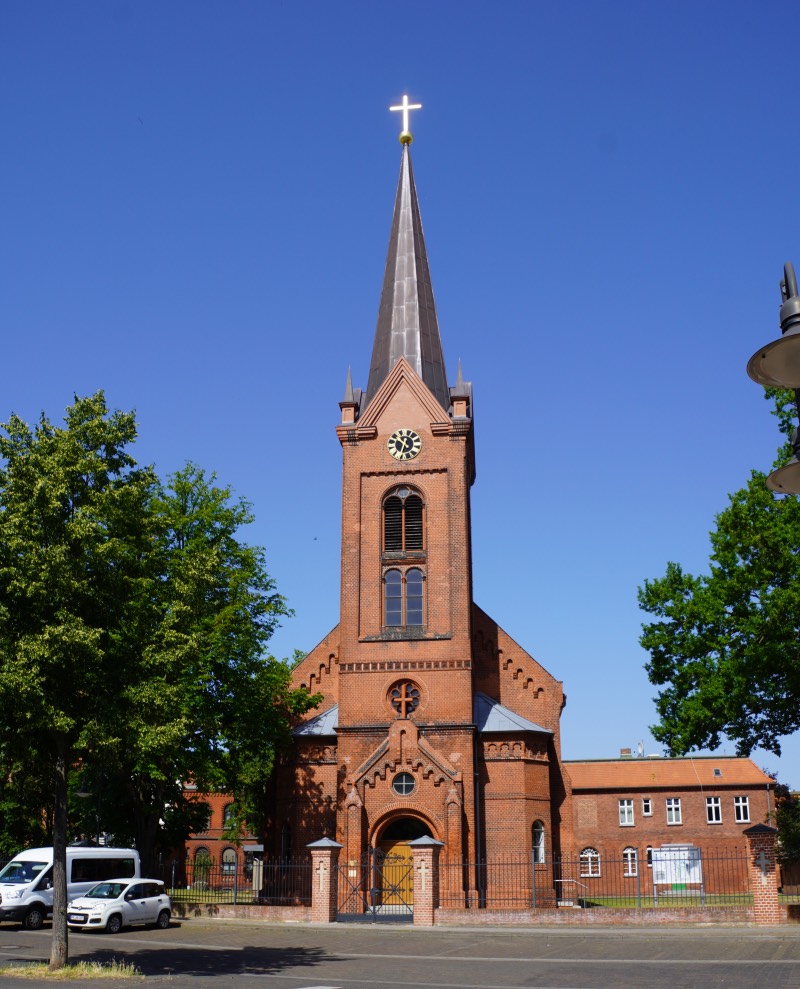
At first, the parish was still without a priest and the citizens organised parish life independently. Every 6 weeks the vicar came to the town for a service. For a long time, there was no suitable room for the services.
Over time, the number of Catholics living in the town grew visibly. In 1893, the previously used rooms were no longer sufficient and the Catholic Church of St. Heinrich was built as a neo-Romanesque brick building with a 42-metre-high tower, which was consecrated in 1989.
During the Second World War, an air raid almost completely destroyed the church. The pastor of the time strongly supported the reconstruction and Christmas 1948 could already be celebrated in the church again, only the 18-metre-high spire was still missing for a long time. It was only put on the tower some time ago and made the sights in Wittenberge complete.
Culture and Festival House Wittenberge
Due to the massive destruction during the Second World War, the city lacked the largest halls for events. The city administration then decided to build a house of culture in the city centre. The foundation stone for the neoclassical building was laid in December 1955.
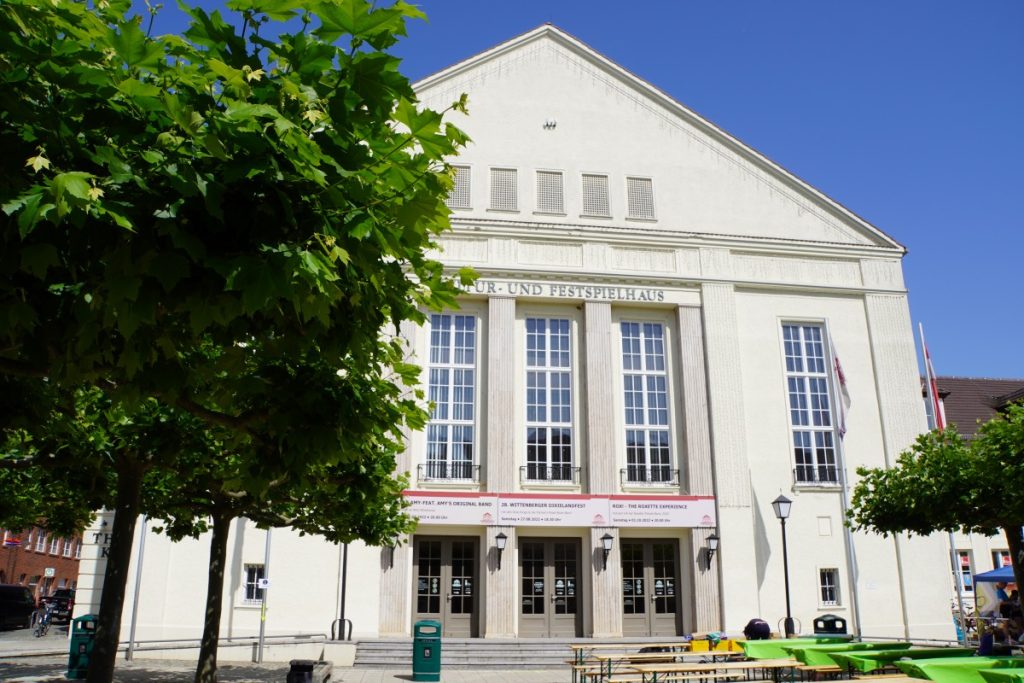
The people of the town helped energetically with the work and even a fire during the construction phase could not diminish the zeal. In October 1959, the Kulturhaus was ceremoniously opened. In 1994, the building was declared a monument and after extensive renovation work, events are now held there again.
Places of interest in Wittenberge: Friedrich-Ludwig-Jahn Primary School
For many students, the school building is certainly not a sight to see in Wittenberge. But one look at the expressive building from 1907 and it becomes clear that this building is worth seeing.
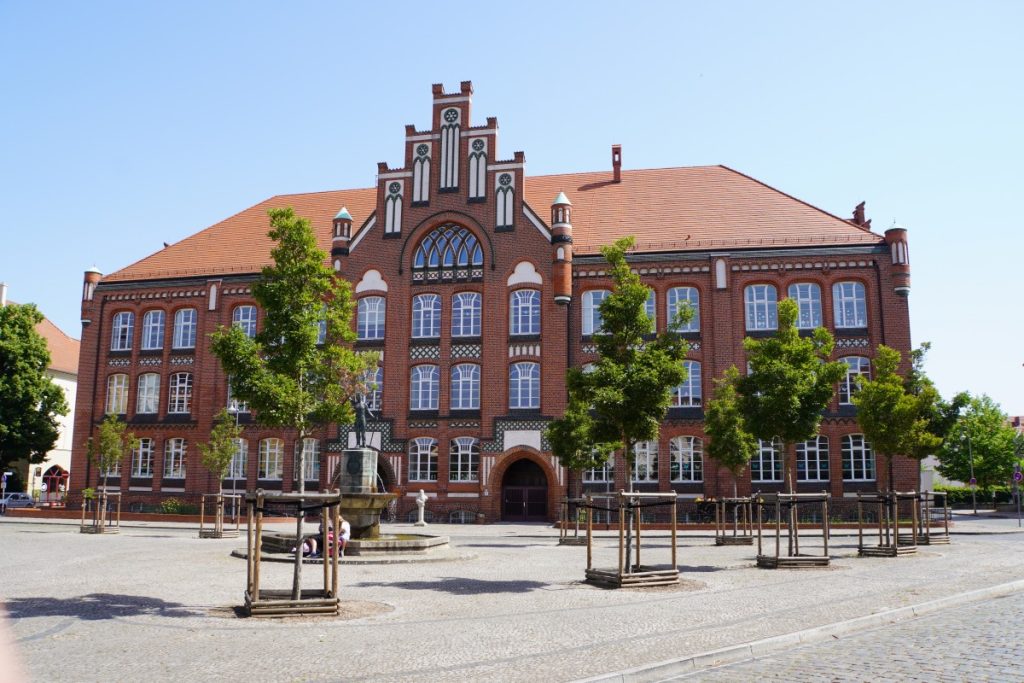
The building is built in neo-Gothic style, even if some elements, such as the skylights of the windows, are more reminiscent of an Art Nouveau building.
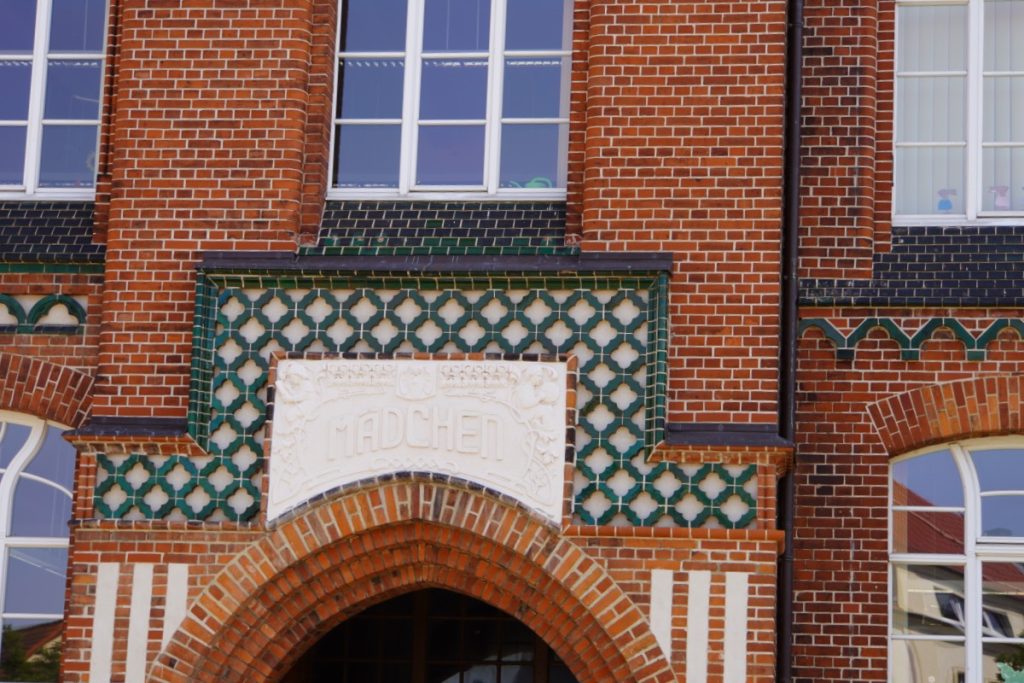
When you stand in front of the school, you notice two large entrance doors. Above the doors, it is clearly marked who is allowed to pass through. For many years, the building and the schoolyard behind it were divided into a boys’ and a girls’ school. To prevent pupils from getting lost, the entrances were marked accordingly. It was not until the 1950s that the separation of the sexes was dropped and there were joint lessons.
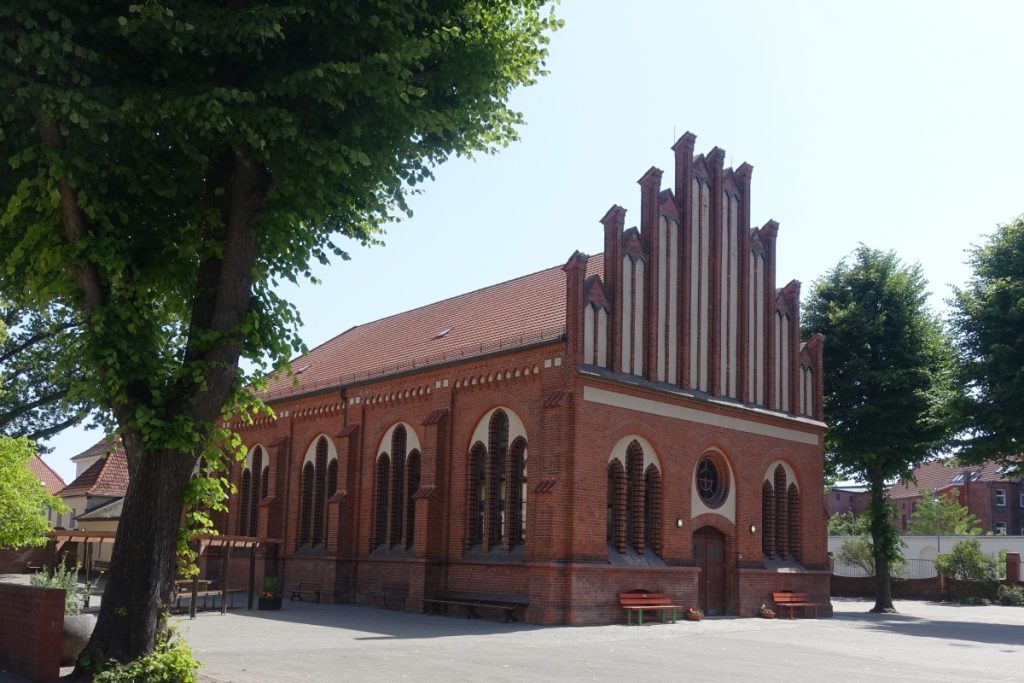
I find the school building very impressive and you should take a look at the gymnasium from a side street. It almost reminds you a little of a church building.
Elbe bridge Wittenberge (railway)
With the construction of the railway connection to Magdeburg, it became necessary to build a bridge over the Elbe. In June 1847, the construction of a 1443-metre-long bridge began. The construction was not easy and, in addition, political unrest pushed the work into the background. A deterioration of the economic situation finally forced the railway company to save money and change the planning.
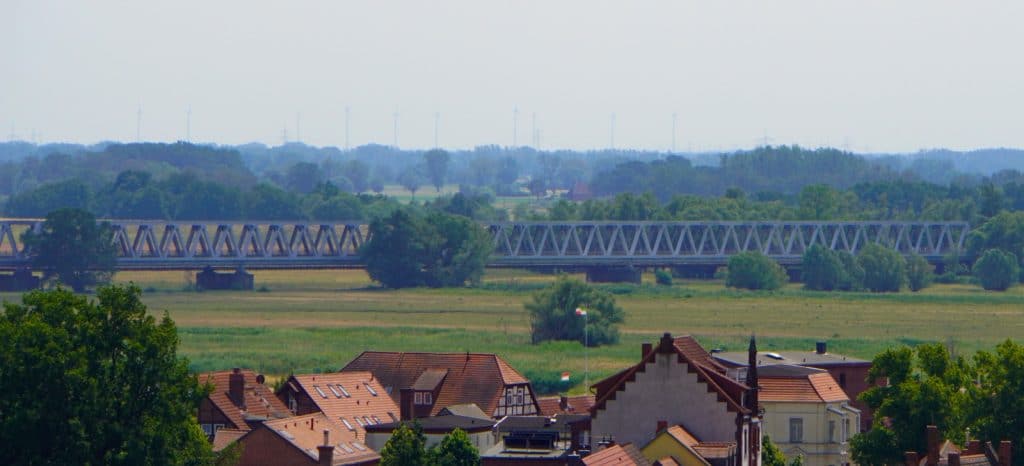
A masonry arch bridge with 5 openings of almost 19 metres each was built on the Wittenberge side. An iron swing bridge with two openings crossed the main stream, followed by a wooden truss construction with 14 openings on masonry piers. On the opposite bank there was another flood bridge made of masonry vaults. The construction must have been impressive. The first trains were able to cross the bridge in 1851.
As was suspected at the time of construction, the “cheap” wooden construction was dilapidated after a short time and was replaced with a wrought-iron truss construction as early as 1883/84.
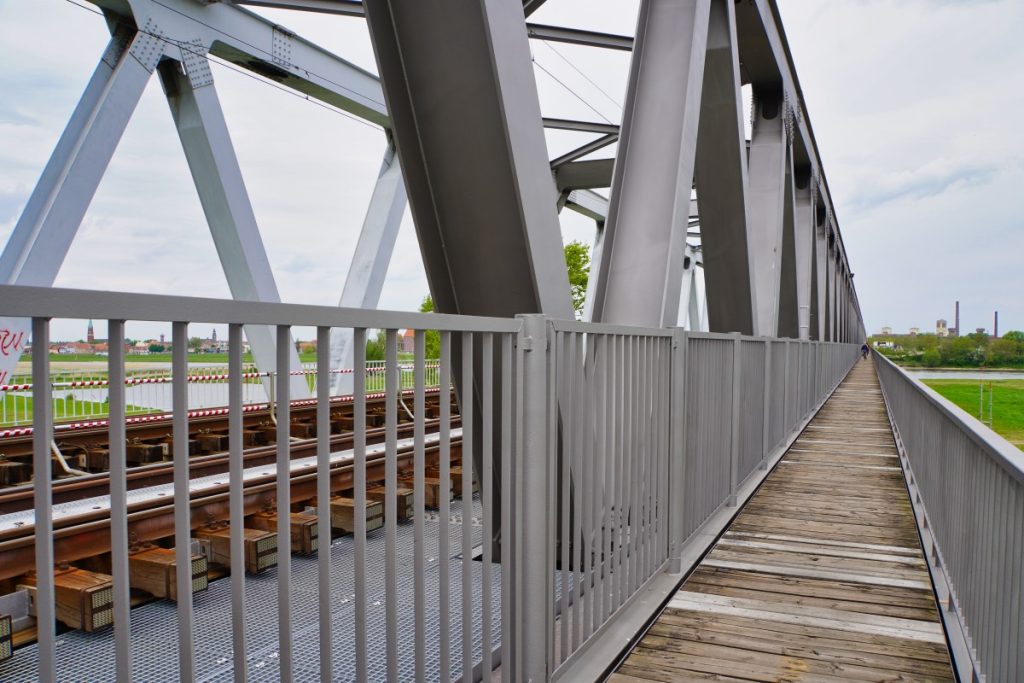
Towards the end of the Second World War (12.4.1945), German troops blew up parts of the bridge, blocking shipping and railway traffic. In autumn 1945, Soviet troops had erected a single-track makeshift bridge, thus making railway traffic possible again.
Until 1950, a temporary bridge remained in place, on which a single-track train could travel at a maximum speed of 30 km/h. In 1955/57, a new bridge was finally completed on which road traffic was also possible. With the increase in road and rail traffic, there were often long waiting times. Either only cars or only trains could cross the bridge.
With the electrification of the railway line, the existing bridge was replaced by a new 1030-metre-long bridge. It was the longest new bridge built by the Deutsche Reichsbahn. A narrow wooden-planked pedestrian path now leads over the bridge. From there, you can have a good look over the Elbe.
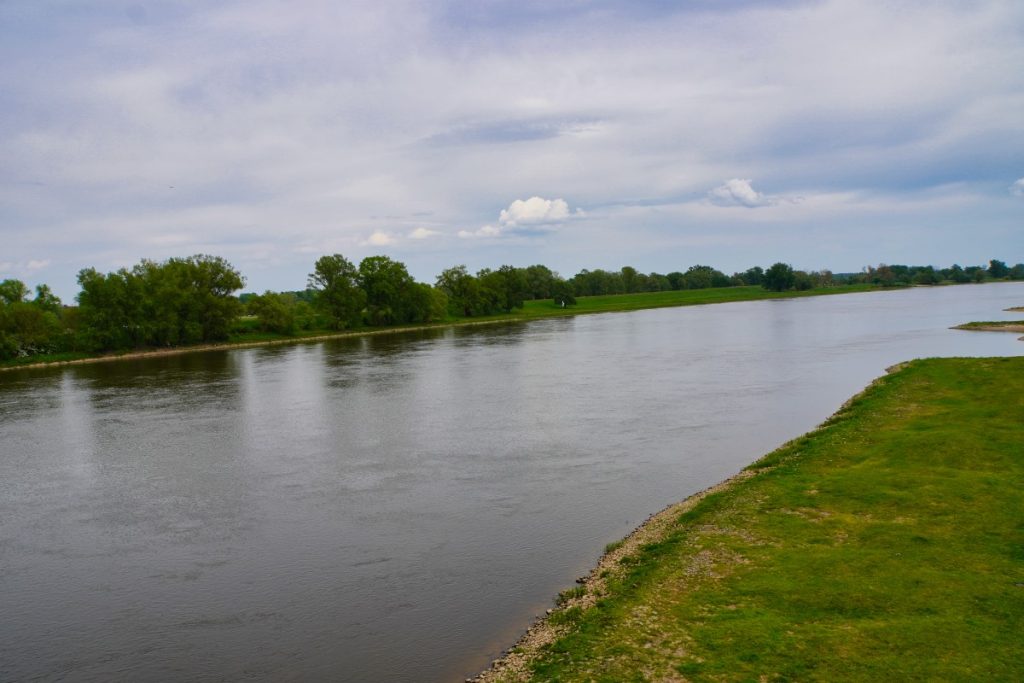
Sights in Wittenberge: Clock Tower and the Sewing Machine Factory
The American Singer Company founded a second factory in Wittenberge in 1904 with the aim of producing sewing machines. It earned the town the title “City of Sewing Machines”. The clock tower, which is said to be the largest free-standing clock tower in Germany and is the town’s landmark, was built directly on the factory grounds in 1928.
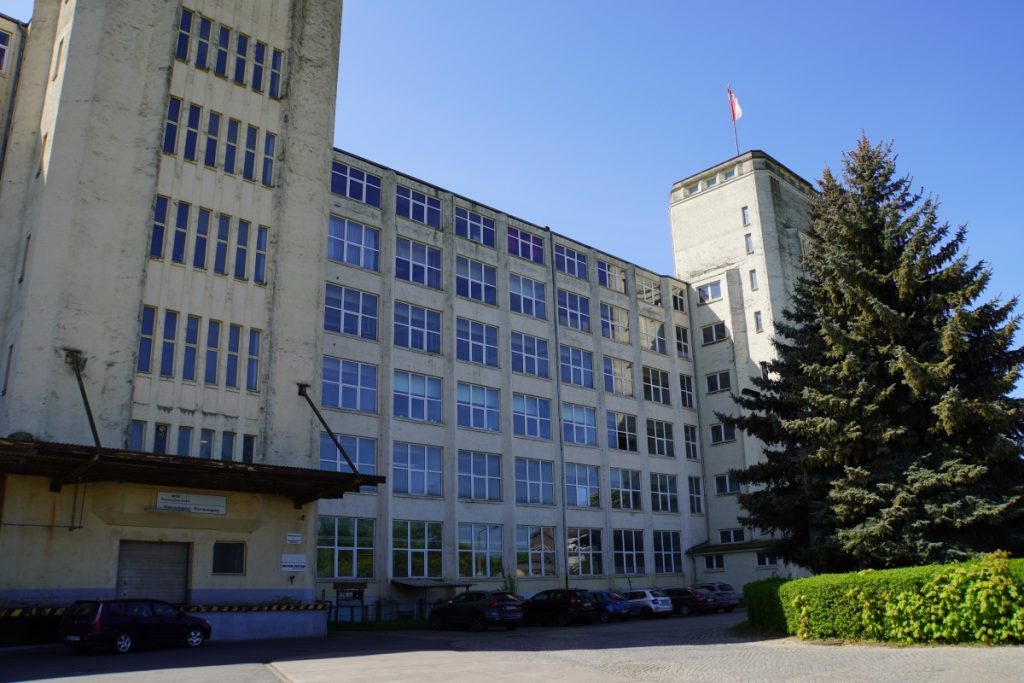
After the Second World War, the factory was dismantled as a reparation service. A few years later, as VEB Nähmaschinenwerk Wittenberge – Kombinat TEXTIMA, and later as Kombinat VEB Nähmaschinenwerk Wittenberge, they produced sewing machines that were exported worldwide.
After reunification, the trust company liquidated the factory. Today, part of the building is used by a school, other areas are used by various companies or stand empty.
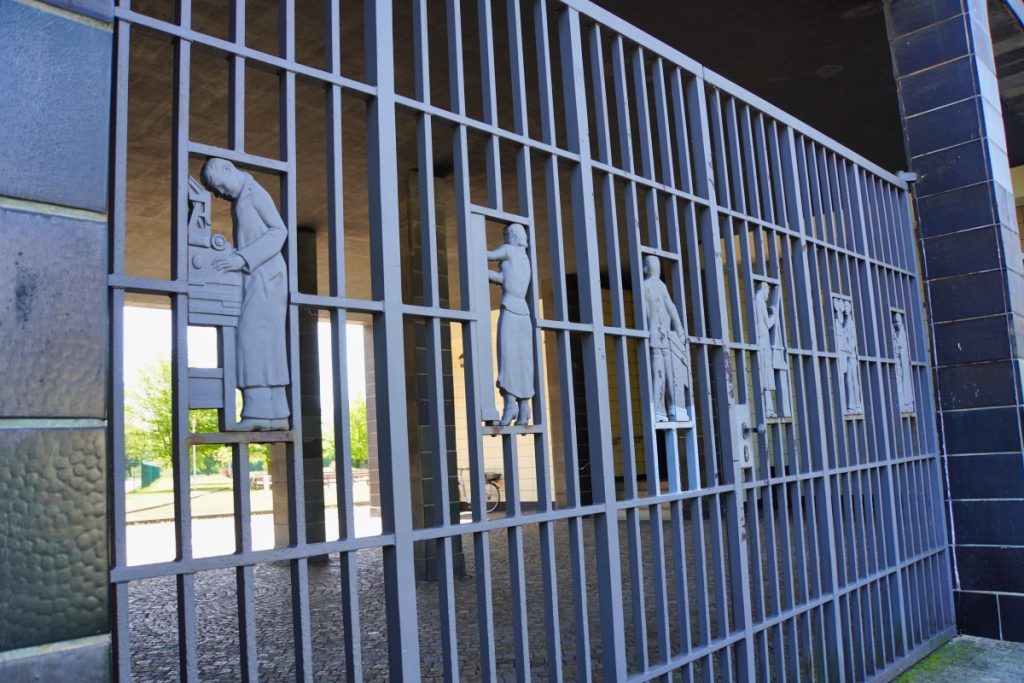
The ensemble of buildings is impressive and rightly one of the most important sights in Wittenberge. Most of the buildings are built in reinforced concrete or in the North German brick style. In keeping with the American parent company, the length of the buildings is measured in inches.
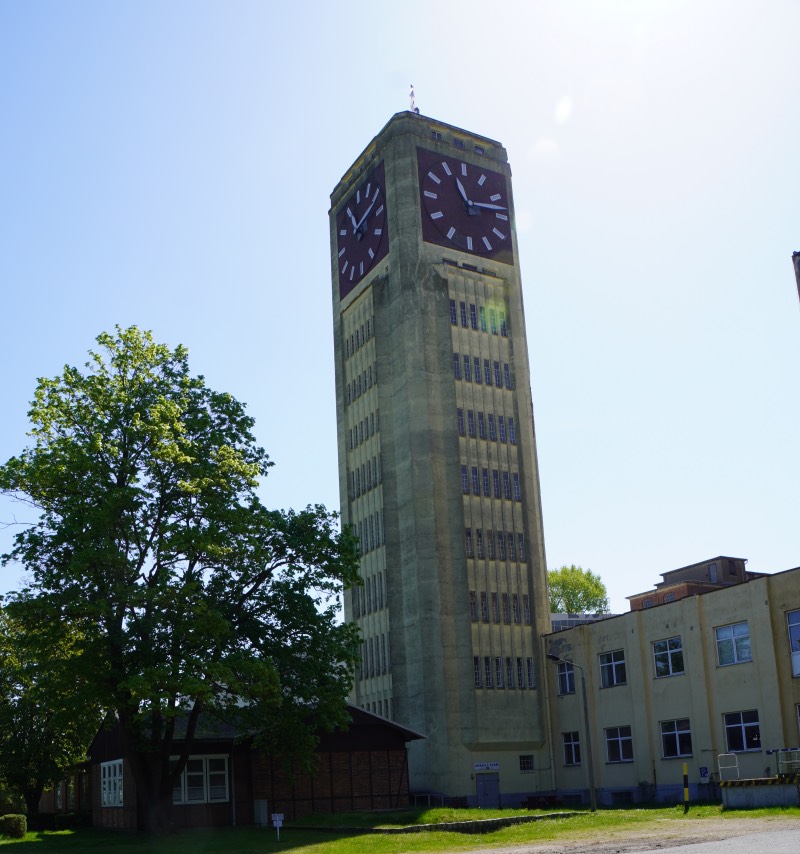
The clock tower is plastered in yellow and shows clear expressionist influence. It was originally intended as a water tower to supply the sewing machine factory and contained service water for fire protection.
After it was damaged during the Second World War, the tower was decommissioned. The tower has 4 clocks, all of which have independent drives. The dials are illuminated and have a diameter of 7.57 metres. Each digit is over one metre high and the large hand is 3.30 metres long. Because of the size and the illumination, you can still see the clock a good 12 kilometres away.
The visit to the town hall and the Art Nouveau tour were part of a research tour to Wittenberge.

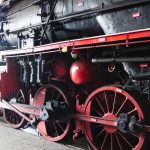
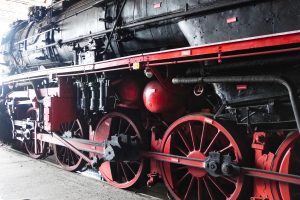
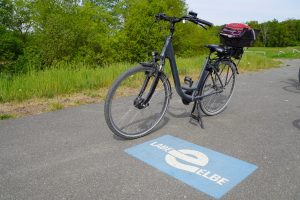
Leave a Reply